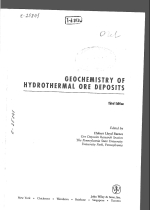Добрый день, Коллеги. Важное сообщение, просьба принять участие. Музей Ферсмана ищет помощь для реставрационных работ в помещении. Подробности по ссылке
Geochemistry of hydrothermal ore deposits (Главы 12-17) / Геохимия гидротермальных рудных месторождений
Organic matter is associated frequently with several types of ore deposits. Examples include uranium deposits, Mississippi Valley-type (MVT) bad-zinc deposits, Carlin-typc disseminated gold deposits, and black shale deposits. This association has led to suggestions that the organic material has been involved in ore genesis for many metals and in differing geological environments. Until recently, however, organic geochemical studies have lagged behind inorganic geochemical approaches. The prime reason has been the analytical difficulty in resolving and identifying the range of organic compounds in geological systems. This problem was resolved in the 1960s by the successful coupling of a separation technique, gas chromatography, with a meth\od for determining molecular mass and structure, mass specttrometry. At the start of a metallogenic study, it is necessary to consider critically whether the organic matter could have been passive or active in ore genesis. If passive, considerable information still can be obtained on ore genesis. Organic matter is a sensitive recorder for many events affecting host rocks, including thermal maturation (Douglas et al., 1970), oxidation (McPhee and Nandi, 1981; Havens et al., 1983), leaching {Hunt, 1979) <...>




